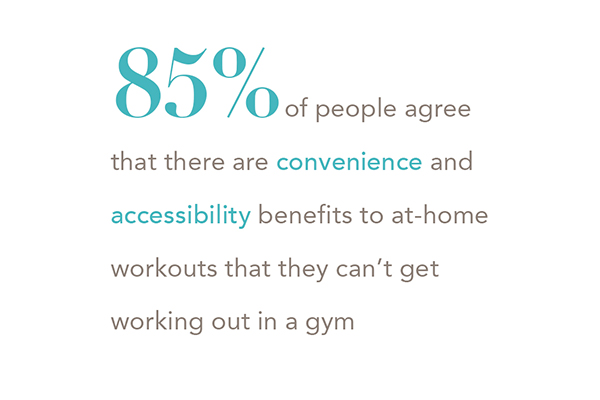The Future of Fitness: Home Workouts

Pre-COVID-19, working out at home was a convenient option.
Now it’s an essential part of our new normal — today and in the foreseeable future.
In fact, according to a survey of adults who exercise regularly, 87% of those who already or will feel comfortable returning to the gym will keep at-home workouts as a part of their fitness routine.*
Other survey highlights:
- 85% of adults who exercise plan to do so at home over the next three months
- 85% agree that there are convenience and accessibility benefits to at-home workouts that they can’t get working out in a gym
- 87% of those who plan to return to the gym say they will continue to work out at home at least some of the time

Read on for more results from the Future of Fitness Survey:
Americans have embraced working out at home to keep up with their exercise and fitness routines.
In fact, two-thirds (66%) work out at home at least 3 times or more a week, according to a survey of 1,000 adults who exercise.
- Almost all have tried working out at home (97%), and most work out at home at least once a week or more (92%).
- The top benefits of working out at home are its convenience (44%), privacy (41%), and cost (40%).
Concerns about getting out of shape during the lockdown faded as Americans realized how effective their at-home routine could be.
More than 4 in 5 (86%) say their at-home workouts have been as good or better than they expected — including 46% who say home workouts exceeded their expectations.
- Those who work out at home more often (3+ times a week) are more likely to find home workouts are better than expected (54%) than those who work out at home less than 3 times a week (28%).

Americans are finding their time invested in workouts at home to be quite productive.
An overwhelming majority (90%) of adults who exercise describe their at-home workouts as effective, including a majority (54%) who say it’s been very or extremely effective.
- Two-thirds of those (66%) who work out at home 3 or more times a week are seeing significant results. They found their home workouts extremely or very effective compared to less than a third (28%) who work out at home less than 3 times a week.
- 75% of those who work out most frequently (6+ times) find their home workouts extremely or very effective compared to those who work out 3-5 times a week (56%) and those who work out 1-2 times a week (30%).
Gyms are expected to continue to be a vital part of working out, but a vast majority (85%) of adults who exercise plan to do so at home over the next three months, either inside (67%) or outside (54%) or both.
- Two-thirds (67%) plan to exercise outdoors, including 54% at home and 31% in a public space like a park.
- Though 15% of Americans said they won’t ever feel comfortable working out in a gym, more than half (61%) said they will eventually feel comfortable heading back, while 23% are already comfortable to resume their gym workouts
Those who exercise at home are in sync as to what their approach to working out is going to look like in the new normal.
Once they return to the gym, around 9 in 10 (87%) adults say they’ll also keep working out at home, with most (53%) saying they’ll do so frequently or all the time.
- More than 3 in 5 (63%) say it’s best to have a mix of working out in a gym and at home in the future.
- More than 4 in 5 (85%) agree there are convenience and accessibility benefits to working out at home that they can’t get from working out at the gym.
*Methodological Notes:
The BODi Survey was conducted by Wakefield Research (www.wakefieldresearch.com) between July 24th and July 29th, 2020, among 1,000 U.S. adults who exercise regularly. The data was weighted to ensure an accurate representation of U.S. adults who exercise regularly.
Results of any sample are subject to sampling variation. The magnitude of the variation is measurable and is affected by the number of interviews and the level of the percentages expressing the results. For the interviews conducted in this particular study, the chances are 95 in 100 that a survey result does not vary, plus or minus, by more than 3.1 percentage points from the result that would be obtained if interviews had been conducted with all persons in the universe represented by the sample.
